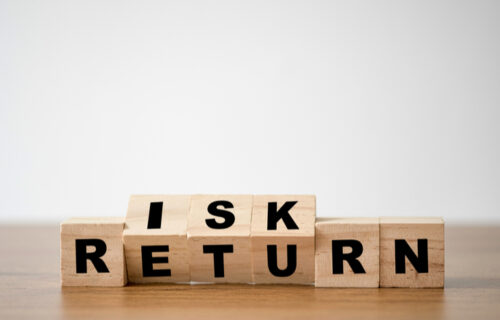“If you want a guarantee, buy a toaster.”
–Clint Eastwood
As frequent readers of this website know, I used to be quite an avid poker player. I was by no means a stellar player, but I was good enough to turn a free $10 into a couple of trips to the World Series of Poker and several vacations. Every time I’d sit down at the table, I’d have an initial set of money that I used to gamble work with. Usually, if I was at a live poker table, that was $100, because I played in the low buy-in games. Managing my bankroll and ensuring I could get my money back if things didn’t go my way was always a crucial part of my poker strategy.
That $100 amount immediately became an anchor in my mind. Since I was a pretty conservative player, I could go several hands without getting involved, and when I did, I usually didn’t finish the hand before dropping out. So, my money on the table would slowly drip down. If I was having a bad night, then instead of making money, my goal became walking away from the table with the money that I’d originally brought to the table. Prospect theory was strong in my Monkey Brain when I played, so I hated the thought of losing much more than I loved the thought of winning.
I speak to a lot of conservative clients (who, admittedly, tend to lean towards the older demographic) who are most concerned with not losing any money. They see the ups and downs in the market, get spooked, extrapolate the swings in the market to their illogical worst possible conclusion, and run for the mattresses, where they want to stuff their money.
It’s understandable. Fear of losing everything, no matter how unlikely or irrational, in the markets is a powerful force. Monkey Brain likes to tell stories that end up with you ending up on the street sampling the different flavors of cat food available in the dumpster behind the local grocery store.
I’m not knocking conservatism. As you get older, it is prudent to dial back the risk in your portfolio.
Dialing back risk, however, is not the same as aiming not to lose your money.
We tend to get focused on return of our money rather than a return on our money.
It’s the wrong measurement.
We should focus on return of purchasing power rather than return of money.

Let’s think about a couple who are both 65 years old, has retired, and has most of their expenses covered by their Social Security payments. They spend about $1,000 a month beyond what they receive in Social Security, but they are very risk averse. They put money into CDs to preserve their capital and pull money out (a nearly impossible assumption, but let’s assume they can do so without penalty) each month to pay their expenses.
Currently, CD rates run about 1% below the rate of inflation. That means that each year, the couple will have to pull out a little bit more money than they did the previous year to buy the same things that they did with the original $1,000 per month.
While CD rates are historically low compared to inflation, neither are they a complete safe haven for retirees. The financial planning industry cites 4% as the safe withdrawal rate in retirement; however, the original study from which the 4% number comes used a 50% bond/50% equities split for investments. In a 100% bond portfolio (which would return slightly more than a complete CD portfolio), the safe withdrawal rate drops to slightly more than 2%. Using aftcasting (which, admittedly, has its flaws), keeping 100% of a retiree’s money in 5 year Treasuries (which approximates CD rates) and withdrawing 4% per year leads to the retiree running out of money within 30 years approximately 59.5% of the time.
The point of all of these numbers is to lead you to one conclusion: just getting your money back is not enough. Inflation, over time, will eat into your assets, meaning that each year, you’ll have to withdraw more and more of your money to buy the same stuff that you did the year before.
Instead of focusing on investing not to lose your money, if you’re a retiree, you should focus on investing not to lose your purchasing power. There’s a significant difference in the mindsets as you can see in the chart above. While investing in the markets is no guarantee, over the long run, you’re much more likely to maintain your ability to buy the same level of things than you are if you retreat into “safe” investments like CDs.
How do you overcome the fear of taking investment risks?

Monkey Brain is strong, and when he’s scared, he screams the loudest. He’s very good at illustrating the bad pictures (you, meet Friskies) but not as good at illustrating the pleasant pictures (you, meet security).
Thus, you need to reframe the image of what you’re trying to protect. If you’re a 65 year old thinking of dumping all of your money into a CD, you’re looking at a number – the total sum of your investable assets – and you don’t want that number to go down. You think that if you put it all in a CD, then in a year, that number will go up, because you’ll get interest. However, what you’re not thinking about is what will happen when you have to withdraw money to live on next year. If inflation is higher than the CD’s interest rate, the number will go down. You’ll have achieved a very short-term goal at the expense of meeting the most important long-term goal – not running out of money.
Instead, you need to mentally picture a future you buying the same things that you currently buy. You inherently know that gas, milk, bread, and healthcare prices go up, so in order to buy those same things in the future, unless you have sufficient assets such that you’re withdrawing less than 2% of your assets per year, you’re going to have to take some risk in investments other than CDs.
As you get older, then you can shift more of your money into safer investments that focus more on return of your money than how much you earn from it. The rule of thumb that I use is 110 – your age for the percentage of your investable assets that should be in equities (the stock market).
You can also withdraw more money as you age. Instead of assuming a 30 year time horizon for a 65 year old, let’s look at the success rates for an 80 year old with a 15 year time horizon. Instead of withdrawing 4% per year, we evaluate an 8% per year withdrawal rate.
Thus, it’s with a mix of numbers and rationality and a little creative thinking that you can get Monkey Brain to settle down in his cage and behave.
Here’s what you need to do:
- Think of your future self buying what you buy as if you were watching a movie. If you watch this move play out in your mind, then you’ll feel much more connected to that future you and want that future self to hit the same goals you have in mind – namely, being able to enjoy the same lifestyle that you enjoy.
- Develop a plan, and automate it as much as possible. Once you’re convinced that your future self will want and enjoy the same lifestyle that you do, you’ll appreciate the need to match or beat inflation to accomplish that goal. At that point, create a plan and set it up so that you have to act as little as possible. If you create a minimum number of decision points, then you reduce the number of opportunities you have to deviate from that plan.
- Stop watching the financial news. If you’re watching CNBC every day, you’re going to convince yourself that you can control the markets. You’ll see patterns in numbers. You’ll be tempted to deviate from your plan, and you’ll give Monkey Brain more ammunition to create those Friskies images in your head. Don’t give Monkey Brain the ammo necessary to derail you from your plans.
If you don’t have enough money in retirement to simply live on the interest until the end of your days, then you’ll need to focus on return of purchasing power rather than return of your money. Not only do you need to have as many chips on the poker table when you stand up as you brought to the table, but you’ll need a few more. You don’t have to leave a winner each time, but over time, you do need to beat inflation. Chucking everything into CDs because you’re scared of losing money will ensure one outcome: you’ll lose money over time.
How do you deal with scared money? Tell us about your best Monkey Brain defense mechanisms in the comments below!
Author Profile
- John Davis is a nationally recognized expert on credit reporting, credit scoring, and identity theft. He has written four books about his expertise in the field and has been featured extensively in numerous media outlets such as The Wall Street Journal, The Washington Post, CNN, CBS News, CNBC, Fox Business, and many more. With over 20 years of experience helping consumers understand their credit and identity protection rights, John is passionate about empowering people to take control of their finances. He works with financial institutions to develop consumer-friendly policies that promote financial literacy and responsible borrowing habits.
Latest entries
 Low Income GrantsSeptember 25, 2023How to Get a Free Government Phone: A Step-by-Step Guide
Low Income GrantsSeptember 25, 2023How to Get a Free Government Phone: A Step-by-Step Guide Low Income GrantsSeptember 25, 2023Dental Charities That Help With Dental Costs
Low Income GrantsSeptember 25, 2023Dental Charities That Help With Dental Costs Low Income GrantsSeptember 25, 2023Low-Cost Hearing Aids for Seniors: A Comprehensive Guide
Low Income GrantsSeptember 25, 2023Low-Cost Hearing Aids for Seniors: A Comprehensive Guide Low Income GrantsSeptember 25, 2023Second Chance Apartments that Accept Evictions: A Comprehensive Guide
Low Income GrantsSeptember 25, 2023Second Chance Apartments that Accept Evictions: A Comprehensive Guide

